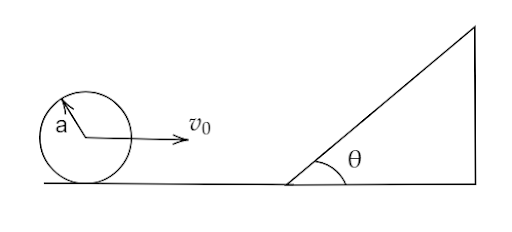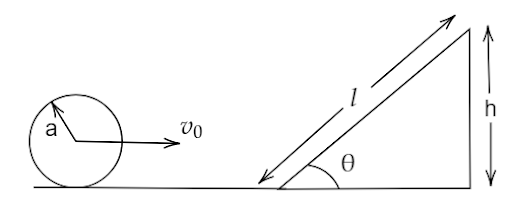
A sphere of radius ‘a’ and mass ‘m’ rolls along a horizontal plane with constant speed\[{v_0}\]. It encounters an inclined plane at angle \[\theta \] and climbs upward. Assuming that it rolls without slipping how far up the sphere will travel (along the incline)?

A. \[\dfrac{{\left( {\dfrac{2}{5}} \right){v_0}^2}}{{g\sin \theta }}\]
B. \[\dfrac{{10{v_0}^2}}{{7g\sin \theta }}\]
C. \[\dfrac{{{v_0}^2}}{{5g\sin \theta }}\]
D. \[\dfrac{{7{v_0}^2}}{{10g\sin \theta }}\]
Answer
220.2k+ views
Hint: Before we start addressing the question, we need to know about the inclined plane. It is a simple machine that consists of a sloping surface that is used for raising heavy bodies. If the incline plane’s angle keeps getting steeper, the force required also increases till it becomes equal to the weight of the object.
Formula Used:
From the conservation of energy, the formula is given by,
\[T{E_i} = T{E_f}\]
Where, \[T{E_i}\] is initial total energy and \[T{E_f}\] is final total energy.
Complete step by step solution:

Consider a sphere of radius ‘a’ and mass ‘m’ rolls along the horizontal plane with constant speed (linear velocity)\[{v_0}\]. If the sphere is rolling without slipping then its angular velocity will be \[\omega \]and it reaches the inclined plane and starts climbing. We need to find how far the sphere will travel on an inclined plane.
In order to find that, we have
Initial total energy =final total energy
\[T{E_i} = T{E_f}\]
\[\Rightarrow K{E_{\left( {trans} \right)i}} + K{E_{\left( {rot} \right)i}} + P{E_i} = K{E_{\left( {trans} \right)f}} + K{E_{\left( {rot} \right)f}} + P{E_f}\]
We know that the total energy is equal to the sum of kinetic energy and potential energy.
\[\dfrac{1}{2}m{v_0}^2 + \dfrac{1}{2}I{\omega _0}^2 + 0 = 0 + 0 + mgh\]
\[\Rightarrow \dfrac{1}{2}m{v_0}^2 + \dfrac{1}{2}I{\omega _0}^2 = mgh\]
Since we know that, the moment of inertia is \[\dfrac{2}{5}m{a^2}\](radius \[r = a\]here) and by using the relation between linear and angular velocity,
\[\omega = \dfrac{v}{r}\]
\[ \Rightarrow \omega = \dfrac{v}{a}\].
Then the above equation will become,
\[\dfrac{1}{2}m{v_0}^2 + \dfrac{1}{2} \times \dfrac{2}{5}m{a^2}\dfrac{{{v_0}^2}}{{{a^2}}} = mgh\]
\[\Rightarrow \dfrac{1}{2}m{v_0}^2 + \dfrac{2}{{10}}m{v_0}^2 = mgh\]
\[\Rightarrow m\left( {\dfrac{1}{2}{v_0}^2 + \dfrac{1}{5}{v_0}^2} \right) = mgh\]
\[\Rightarrow gh = \dfrac{7}{{10}}{v_0}^2\]
\[\Rightarrow h = \dfrac{7}{{10g}}{v_0}^2\]
From the triangle,
\[\sin \theta = \dfrac{h}{l}\]
\[ \Rightarrow h = l\sin \theta \]
So, substitute the value in above equation we get,
\[l\sin \theta = \dfrac{7}{{10g}}{v_0}^2\]
\[ \therefore l = \dfrac{{7{v_0}^2}}{{10g\sin \theta }}\]
Therefore, the sphere will travel on an inclined plane at \[\dfrac{{7{v_0}^2}}{{10g\sin \theta }}\]
Hence, Option D is the correct answer.
Note:Remember that, if a sphere of some radius r is rolling with some speed v, then it has both translational and rotational motion. So, if we want to find the total energy then, it includes translational, rotational and also its potential energy.
Formula Used:
From the conservation of energy, the formula is given by,
\[T{E_i} = T{E_f}\]
Where, \[T{E_i}\] is initial total energy and \[T{E_f}\] is final total energy.
Complete step by step solution:

Consider a sphere of radius ‘a’ and mass ‘m’ rolls along the horizontal plane with constant speed (linear velocity)\[{v_0}\]. If the sphere is rolling without slipping then its angular velocity will be \[\omega \]and it reaches the inclined plane and starts climbing. We need to find how far the sphere will travel on an inclined plane.
In order to find that, we have
Initial total energy =final total energy
\[T{E_i} = T{E_f}\]
\[\Rightarrow K{E_{\left( {trans} \right)i}} + K{E_{\left( {rot} \right)i}} + P{E_i} = K{E_{\left( {trans} \right)f}} + K{E_{\left( {rot} \right)f}} + P{E_f}\]
We know that the total energy is equal to the sum of kinetic energy and potential energy.
\[\dfrac{1}{2}m{v_0}^2 + \dfrac{1}{2}I{\omega _0}^2 + 0 = 0 + 0 + mgh\]
\[\Rightarrow \dfrac{1}{2}m{v_0}^2 + \dfrac{1}{2}I{\omega _0}^2 = mgh\]
Since we know that, the moment of inertia is \[\dfrac{2}{5}m{a^2}\](radius \[r = a\]here) and by using the relation between linear and angular velocity,
\[\omega = \dfrac{v}{r}\]
\[ \Rightarrow \omega = \dfrac{v}{a}\].
Then the above equation will become,
\[\dfrac{1}{2}m{v_0}^2 + \dfrac{1}{2} \times \dfrac{2}{5}m{a^2}\dfrac{{{v_0}^2}}{{{a^2}}} = mgh\]
\[\Rightarrow \dfrac{1}{2}m{v_0}^2 + \dfrac{2}{{10}}m{v_0}^2 = mgh\]
\[\Rightarrow m\left( {\dfrac{1}{2}{v_0}^2 + \dfrac{1}{5}{v_0}^2} \right) = mgh\]
\[\Rightarrow gh = \dfrac{7}{{10}}{v_0}^2\]
\[\Rightarrow h = \dfrac{7}{{10g}}{v_0}^2\]
From the triangle,
\[\sin \theta = \dfrac{h}{l}\]
\[ \Rightarrow h = l\sin \theta \]
So, substitute the value in above equation we get,
\[l\sin \theta = \dfrac{7}{{10g}}{v_0}^2\]
\[ \therefore l = \dfrac{{7{v_0}^2}}{{10g\sin \theta }}\]
Therefore, the sphere will travel on an inclined plane at \[\dfrac{{7{v_0}^2}}{{10g\sin \theta }}\]
Hence, Option D is the correct answer.
Note:Remember that, if a sphere of some radius r is rolling with some speed v, then it has both translational and rotational motion. So, if we want to find the total energy then, it includes translational, rotational and also its potential energy.
Recently Updated Pages
Electricity and Magnetism Explained: Key Concepts & Applications

JEE Energetics Important Concepts and Tips for Exam Preparation

JEE Isolation, Preparation and Properties of Non-metals Important Concepts and Tips for Exam Preparation

JEE Main 2021 July 25 Shift 1 Question Paper with Answer Key

JEE Main 2021 July 22 Shift 2 Question Paper with Answer Key

States of Matter Chapter For JEE Main Chemistry

Trending doubts
JEE Main 2026: Application Form Open, Exam Dates, Syllabus, Eligibility & Question Papers

Understanding Uniform Acceleration in Physics

Derivation of Equation of Trajectory Explained for Students

Hybridisation in Chemistry – Concept, Types & Applications

Understanding the Angle of Deviation in a Prism

How to Convert a Galvanometer into an Ammeter or Voltmeter

Other Pages
Thermodynamics Class 11 Physics Chapter 11 CBSE Notes - 2025-26

JEE Advanced Marks vs Ranks 2025: Understanding Category-wise Qualifying Marks and Previous Year Cut-offs

Units And Measurements Class 11 Physics Chapter 1 CBSE Notes - 2025-26

NCERT Solutions For Class 11 Physics Chapter 8 Mechanical Properties Of Solids

Motion in a Straight Line Class 11 Physics Chapter 2 CBSE Notes - 2025-26

NCERT Solutions for Class 11 Physics Chapter 7 Gravitation 2025-26




